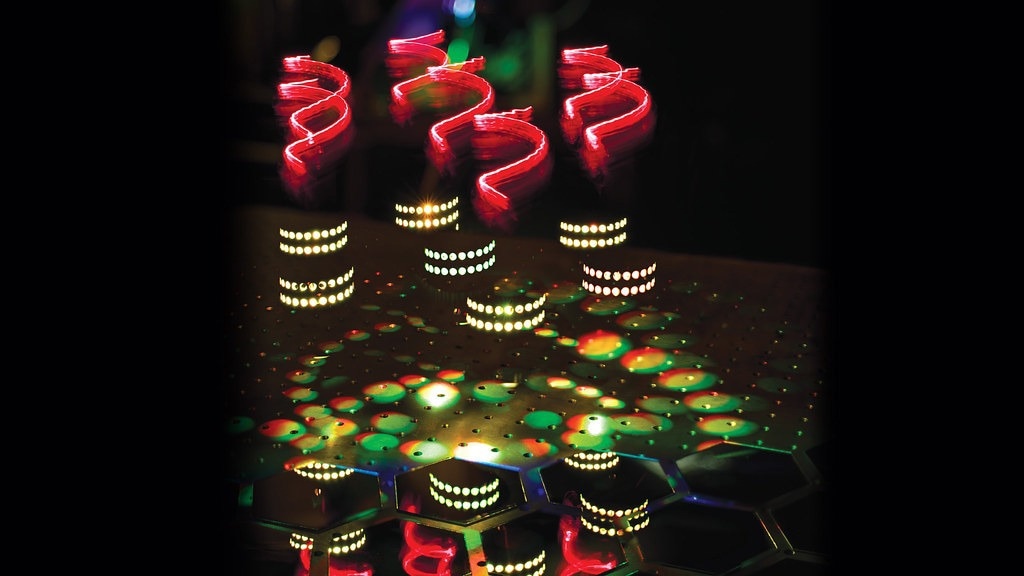An international team of researchers, led by physicists from the University of Bath, has recently uncovered a novel optical phenomenon with considerable implications across various fields, including pharmaceutical science, security, forensics, environmental science, art conservation, and medicine.

Artistic representation of hyper-Raman optical activity. Image Credit: Ventsislav Valev and Kylian Valev
Molecules exhibit specific rotational and vibrational patterns that affect how light interacts with them. When illuminated, light scatters off these molecules, and among the millions of light particles (photons), only one photon may change color—a phenomenon known as the Raman effect. By capturing numerous of these color-shifting photons, scientists can map out the energy states of molecules and identify them.
However, certain molecular features are not detectable through the Raman effect alone. To address this, researchers use a technique called 'hyper-Raman'.
Hyper-Raman Effect
The hyper-Raman effect builds upon the Raman effect by involving two photons that simultaneously interact with a molecule and merge to produce a single photon with a Raman-induced color change. This advanced technique can penetrate deeper into living tissues, is less likely to cause molecular damage, and provides images with enhanced contrast by reducing autofluorescence noise. Though the number of hyper-Raman photons is even smaller than Raman photons, their quantity can be amplified by the presence of tiny metal nanoparticles near the molecules.
Despite these advantages, hyper-Raman spectroscopy has struggled to investigate a critical property of life—chirality.
Optical Activity
Chirality in molecules refers to their "handedness" or twist, similar to the helical structure of DNA. Many biomolecules, such as proteins, RNA, sugars, amino acids, certain vitamins, steroids, and alkaloids, exhibit chirality.
Light itself can also be chiral. In 1979, researchers David L. Andrews and Thiruiappah Thirunamachandran proposed that using chiral light in the hyper-Raman effect could provide three-dimensional insights into molecular chirality.
However, detecting this effect—termed hyper-Raman optical activity—has proven challenging. The effect is extremely subtle, making it difficult to measure. Efforts to observe it have been hampered by the need for highly pure chiral light and the damage caused to molecules by high laser powers.
While previous attempts aimed to measure the effect directly from chiral molecules, we took an indirect approach. We employed molecules that are not chiral by themselves, but we made them chiral by assembling them on a chiral scaffold. Specifically, we deposited molecules on tiny gold nanohelices that effectively conferred their twist (chirality) to the molecules.
Ventsislav Valev, Study Lead and Professor, University of Bath
Valev added, “The gold nanohelices have another very significant benefit – they serve as tiny antennas and focus light onto the molecules. This process augments the hyper-Raman signal and helps us to detect it. Such nanohelices were not featured on the 1979 theory paper and to account for them we turned to none other than one of the original authors and pioneer of this research field.”
Confirming a 45-Year-Old Theory
It is very gratifying to see this work the experimental finally confirm our theoretical prediction, after all these years. The team from Bath have performed an outstanding experiment.
Andrews, Emeritus Study Co-Author and Professor, University of East Anglia
The newly discovered effect holds significant potential for a variety of applications. It could be instrumental in analyzing pharmaceutical compositions and ensuring their quality. This technology has the potential to verify the authenticity of products and detect counterfeits. Additionally, it could be utilized to identify illegal drugs and explosives at customs or crime scenes.
In environmental science, this technique could aid in detecting pollutants in air, water, and soil samples. It may also be useful in art conservation by revealing the composition of pigments and assisting in the preservation and restoration of artworks. Furthermore, this effect shows promise for clinical applications, potentially enhancing medical diagnostics by identifying molecular changes associated with diseases.
Professor Valev said, “This research work has been a collaboration between chemical theory and experimental physics across many decades and across academics of all stages from PhD student to Emeritus Professor. We hope it will inspire other scientists and that it will raise awareness that scientific progress often takes many decades.”
Valev further added: “Ours is the very first observation of a fundamental physical mechanism. There is a long way ahead until the effect can be implemented as a standard analytical tool that other scientist can adopt. We look forward to the journey, together with our collaborators from Renishaw PLC, a world-renowned manufacturer of Raman spectrometers.”
Dr Robin Jones, Study First Author for the new research paper and a PhD student at Bath until recently, added, “Performing the experiments that showed the hyper-Raman optical activity effect has been my most rewarding academic experience. In retrospect, it seems that almost every step of my PhD was like a piece of the puzzle which fell into place to achieve the observation.”
Journal Reference:
Jones, R. R., et al. (2024) Chirality conferral enables the observation of hyper-Raman optical activity. Nature Photonics. doi:10.1038/s41566-024-01486-z